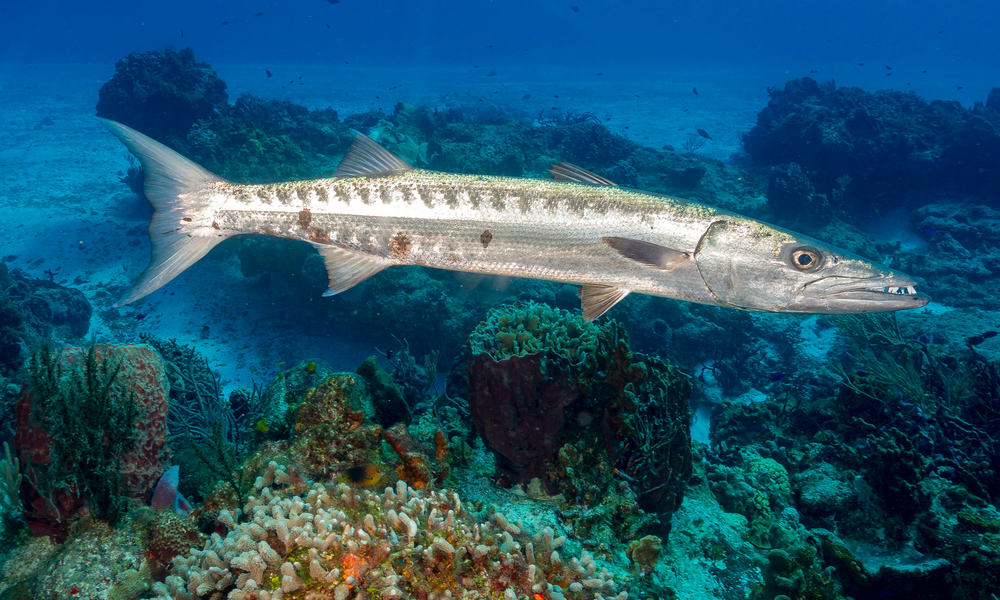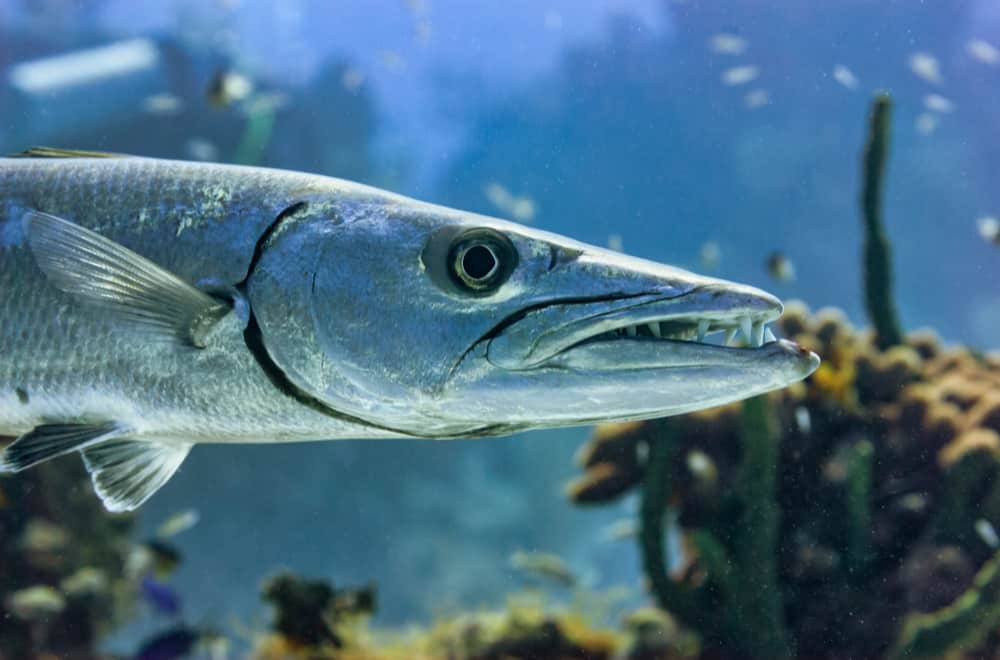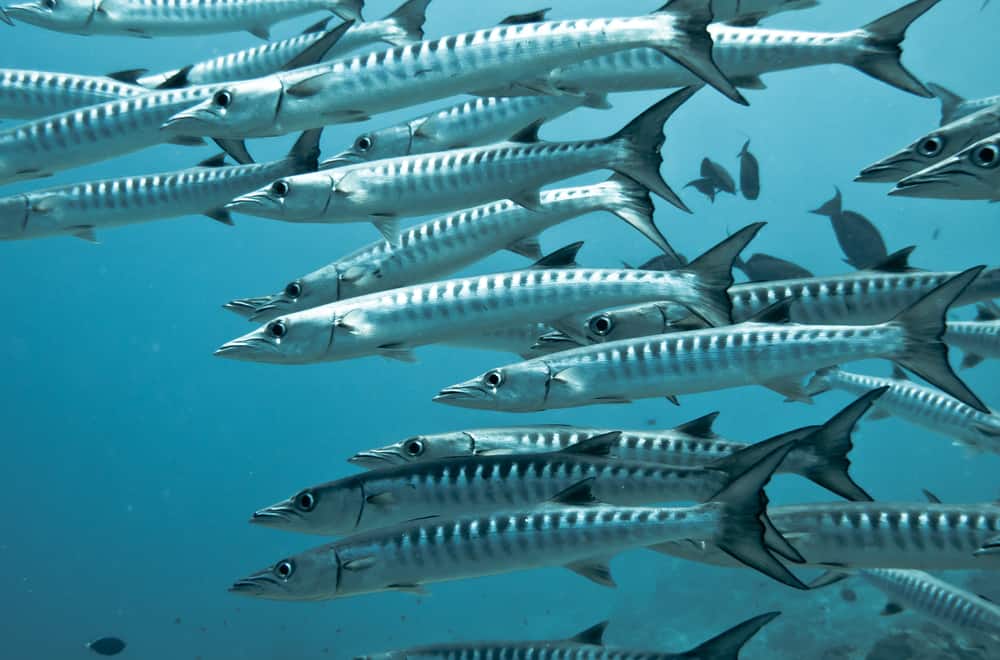For many years, barracudas have been portrayed as a sea danger, but really, these creatures don’t deserve such a mean reputation. Sure, they may charge toward you, teeth first, but barracudas don’t eat humans. In fact, they rarely attack humans and if they do, the attacks are almost never fatal.
So, what do barracudas eat, you may ask? Let’s find out.
Barracuda Habits and Biology
The barracuda is a common name given to fish species in the Sphyraenidae family. There are more than 20 species of barracudas, with the majority residing in warm and tropical waters.
Even if you don’t know much about fish, you will quickly recognize barracudas’ distinctive look. They have a sleek, elongated body, a large mouth with an impressive set of sharp teeth, and a jutting lower jaw.
Their color varies from species to species, but the majority have hues of silvers, blue, gray, green, and white bellies. Size varies too; smaller species of barracuda max out at about 25 inches in length and15 pounds in weight while larger species can grow up to 6 feet tall and weigh over 80 pounds.
Most species live near the shore where there are coral reefs, mangroves, or seagrass beds. They are mainly saltwater fish but there are some species that tolerate brackish water.
Barracudas are among the fastest creatures in the marine environment and can swim up to 35 mph. They, however, can’t maintain a high speed for a long time; they run in short bursts and this is mostly when they are pursuing prey.
For the most part, barracudas will swim at a low speed looking for food but as soon as they find a meal within reach, they will charge toward it. They often swim in schools to hunt or for safety; depending on the species, they can swim in small or large groups.
Because of their size, barracudas usually don’t have many predators besides dolphins, sharks, and Goliath groupers. If they don’t bump into anglers, they can live for a really long time. Most barracudas have been found to live between 12 and 16 years.
Males become sexually mature at 2 years while females take up to 4 years to reach sexual maturity. The females lay eggs in open waters where they are fertilized by the males and left to hatch. Newly hatched barracudas move to shallow, vegetated estuaries where they live until they have reached about 2 inches long.
What Do Barracudas Eat in Wild?
Barracudas are carnivores with powerful jaws that will cut even the largest of prey in half. They are opportunistic predators who will either actively chase after prey or sit and wait to ambush. When they ambush, they do it so fast, as they are capable of moving at incredible speeds. Most of the prey they aim at is not able to escape.
Also, unlike most fish species, barracudas do not use the sense of smell to hunt for food. They use their eyes instead and will quickly be attracted to shiny objects in the water such as white or silverfish.
Check out this video of a barracuda hunting and catching prey:
What Do Barracudas like to Eat?
Barracudas have a vast diet but they prefer:
- Mullets
- Tune
- Grunts
- Snappers
- Jacks
- Groupers
- Anchovies
- Herrings
- Killifish
Are Barracudas Maneaters?
No, barracudas do not eat humans, but they can attack them. Because they are attracted to shiny objects, a diver or swimmer with anything reflective will likely be ambushed by a curious barracuda.
But such attacks are rare and usually not fatal. Even if the barracuda comes charging toward you, the chances of it biting you are still quite low. The only time these creatures are likely to bite is if they mistake a shiny object that you have for a fish and try to snatch it. And as soon as they realize the object is not food, they will stop biting.
The teeth may do some damage to a leg or arm, though, and you may even require a few stitches. But other than that, you should be fine swimming with barracudas. Just make sure to remove anything shiny prior to jumping into the water.
How Barracudas’ Diet Benefits the Ecosystem
Barracudas play an important role in the marine food web. The fish they prey on are mostly species that feed on algae, seagrass, and coral reefs. By eating these species, they reduce their population, which gives the sea vegetation a better chance to grow and flourish.
And because barracudas are usually not safe for human consumption, their population remains relatively abundant, meaning, there is a pretty good chance that prey fish populations will remain under control for a long time.
9 Facts About Barracudas
1. Barracudas Don’t Care for Their Eggs
Barracudas lay eggs in the spring. Once the males have fertilized them, they leave the eggs drifting out in the sea where they are dispersed to different parts by water currents.
Many eggs are damaged or preyed upon during this period but because barracudas shed them in large numbers (about 50, 000 eggs at once), plenty of them are still able to survive and hatch. The baby barracudas will usually seek shallow weedy areas.
2. Barracudas Get Quite Heavy
While most barracudas will weigh somewhere between 14 and 20 pounds, some species grow really big. The biggest barracuda recorded weighed 102 pounds and had a length of 7 feet! That’s close to the weight of a 13 or 14-year-old human.
And for the record, even a 14-pound fish is not as light as many people may think. It actually has about the same weight as that big can of paint you would see in a local hardware store.
3. Barracudas Are Social Animals
Although adult barracudas mostly swim alone, the younger ones live and swim in schools regardless of the species.
Swimming together helps keep predators away. In fact, sometimes a school of barracudas will assume the shape of a tornado while they move through the sea to further confuse their enemies.
4. Barracudas Are Competitive
Barracudas are aggressive creatures and will compete with other marine animals when hunting for food. If a larger fish is going for prey and a barracuda happens to see it, the barracuda will try to fight the competitor to get the meal for itself. In most cases, barracudas don’t lose a fight.
5. Barracudas Aren’t Safe to Eat
While smaller species of barracudas are considered generally safe for human consumption, the larger species (those above 3 feet long) are not completely safe to consume.
Some of the smaller fish species that barracudas prey on consume algae that have been found to contain toxins, and when barracudas feed on these creatures, they transfer the toxins to their bodies.
When humans eat barracudas, there is a good chance they will ingest the same toxins too. Humans can become extremely ill or even die from ingesting these toxins. How sick a person gets will usually depend on how toxic the barracuda that was consumed happened to be, but symptoms may include nausea and vomiting.
6. Barracudas Have Two Sets of Teeth
Barracudas, like moray eels, have both a front and an inner set of teeth to serve different purposes. The front teeth are very sharp and are the ones they use for ripping the prey apart while the innermost set is used to chop the prey.
7. Barracudas Can Adjust the Size of Their Swim Bladder
A swim bladder is an organ contained in most bony fish species to help them swim without sinking or floating upward. Barracudas are able to inflate or deflate their swim bladder to quickly move through coral regions that are narrow or seemingly inaccessible.
8. Young Barracudas Can Change Their Skin Color
Juvenile barracudas have more predators than older barracudas. Luckily, they can change the color of their skin to camouflage with the surrounding mangroves, coral reefs, and seagrass. This adaptation makes it more difficult for predators to find them.
9. Human Beings Are the Greatest Threat to Barracudas
While barracudas can lose their lives to dolphins, sharks, and Goliath groupers, they face a much greater danger from humans. They suffer not only from sport fishing but also climate change, pollution, and habitat destruction.
Every person can do their part to keep barracudas and their habitat safe by avoiding single-use plastic items, choosing sustainable seafood options, reducing the use of carbon, and encouraging the elected fisheries management officials to protect and preserve the marine environment.
For more interesting facts about barracudas, watch this video:
Summary
Barracuda’s main diet is fish. They will chase after their prey species or sit and wait to ambush. Snorkelers and swimmers have sometimes gotten aggressive bumps from barracudas, but that’s not because the fish is out to capture them. Barracudas don’t eat humans but they are attracted to shiny objects. Divers with reflective objects are more susceptible to barracuda attacks.



Their is no such thing as a tune fish